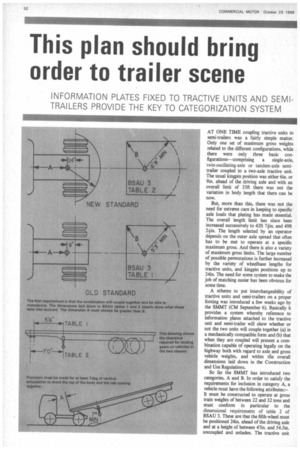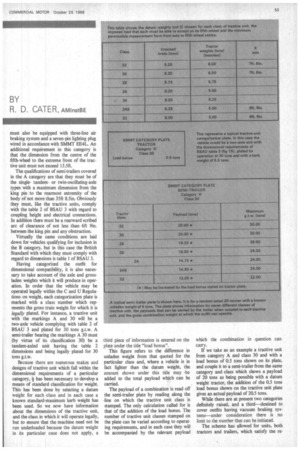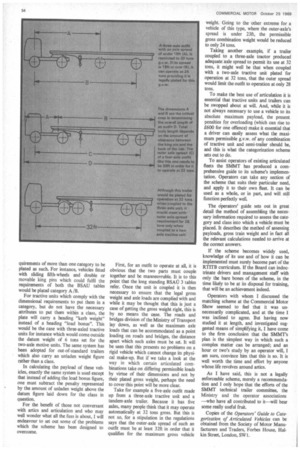This plan should bring order to trailer scene
Page 54

Page 55

Page 56

If you've noticed an error in this article please click here to report it so we can fix it.
INFORMATION PLATES FIXED TO TRACTIVE UNITS AND SEMITRAILERS PROVIDE THE KEY TO CATEGORIZATION SYSTEM BY R. D. CATER, AMInstBE
AT ONE TIME coupling tractive units to semi-trailers was a fairly simple matter. Only one set of maximum gross weights related to the different configurations, while there were only three basic configurations—comprising a single-axle, twin-oscillating-axle or tandem-axle semitrailer coupled to a two-axle tractive unit. The usual kingpin position was either 6in. or 9in. ahead of the driving axle and with an overall limit of 35ft there was not the variation in body length that there can be now.
But, more than this, there was not the need for extreme care in keeping to specific axle loads that plating has made essential. The overall length limit has since been increased successively to 4211 7iin. and 49ft 2iin. The length selected by an operator depends on the outer axle spread that often has to be met to operate at a specific maximum gross. And there is also a variety of maximum gross limits. The large number of possible permutations is further increased by the variety of wheelbase lengths for tractive units, and kingpin positions up to 24in. The need for some system to make the job of matching easier has been obvious for some time.
A scheme to put interchangeability of tractive units and semi-trailers on a proper footing was introduced a few weeks ago by the SMMT (CM September 6). Basically it provides a system whereby reference to information plates attached to the tractive unit and semi-trailer will show whether or not the two units will couple together (a) in a mechanically compatible form and (b) that when they are coupled will present a combination capable of operating legally on the highway both with regard to axle and gross vehicle weights, and within the overall dimensions laid down in the Construction and Use Regulations.
So far the SMMT has introduced two categories, A and B. In order to satisfy the requirements for inclusion in category A, a vehicle must have the following attributes:— It must be constructed to operate at gross train weights of between 22 and 32 tons and must conform in particular to the dimensional requirements of table 2 of BSAU 3. These are that the fifth-wheel must be positioned 24in. ahead of the driving axle and at a height of between 47in. and 54.5 in. uncoupled and unladen. The tractive unit
must also be equipped with three-line air braking system and a seven-pin lighting plug wired in accordance with SMMT EE4L. An additional requirement in this category is that the dimension from the centre of the fifth-wheel to the extreme front of the trac tive unit must not exceed I3.5ft.
The qualifications of semi-trailers covered in the A category are that they must be of the singletandemor twin-oscillating-axle types with a maximum dimension from the king pin to the rearmost extremity of the body of not more than 35)1 8.5in. Obviously they must, like the tractive units, comply with the table 2 of BSAU 3 with regard to coupling height and electrical connections. In addition the must be a rearward scribed arc of clearance of not less than 6ft 9in. between the king pin and any obstruction.
Virtually the same conditions are laid down for vehicles qualifying for inclusion in the B category, but in this case the British Standard with which they must comply with regard to dimensions is table I of BSAU 3.
Having categorized the outfit for dimensional compatibility, it is also neces sary to take account of the axle and grossladen weights which it will produce in operation. In order that the vehicle may be operated legally within the C and U Regulations on weight, each categorization plate is marked with a class number which represents the gross train weight for which it is legally plated. For instance, a tractive unit with the markings A and 30 will be a two-axle vehicle complying with table 2 of BSAU 3 and plated for 30 tons g.t.w. A semi-trailer bearing the markings A 30 must (by virtue of its classification 30) be a tandem-axled unit having the table 2 dimensions and being legally plated for 30 tons g.t.w.
Because there are numerous makes and designs of tractive unit which fall within the dimensional requirements of a particular category, i has been necessary to develop a means of standard classification for weight. This has been done by selecting a datum weight for each class and in each case a known standard-maximum kerb weight has been used. So we now have information about the dimensions of the tractive unit, and the class in which it will operate legally, but to ensure that the machine need not be run underloaded because the datum weight in its particular case does not apply, a third piece of information is entered on the plate under the title "load bonus".
This figure refers to the difference in unladen weight from that quoted for the particular class and, where a vehicle is in fact lighter than the datum weight, the amount shown under this title may 'be added to the total payload which can be carried.
The payload of a combination is read off the semi-trailer plate by reading along the line on which the tractive unit class is stamped. The only calculation called for is that of the addition of the load bonus. The number of tractive unit classes stamped on the plate can be varied according to operating requirements, and in each case they will be accompanied by the relevant payload which the combination in question can carry.
If we take as an example a tractive unit from category A and class 30 and with a load bonus of 0.5 tons shown on its plate, and couple it to a semi-trailer from the same category and class which shows a payload of 20 tons as being possible with a datum weight tractor, the addition of the 0.5 tons load bonus shown on the tractive unit plate gives an actual payload of 20.5 tons.
While there are at present two categories definitely raised, and a third destined to cover outfits having vacuum braking systems-under consideration there is no limit to the number that can be initiated.
The scheme has allowed for units, both tractors and trailers, which satisfy tile re quirements of more than one category to be plated as such. For instance, vehicles fitted with sliding fifth-wheels and double or movable king pins which could fulfil the requirements of both the BSAU tables would be plated category A/B.
For tractive units which comply with the dimensional requirements to put them in a category, but do not have the necessary attributes to put them within a class, the plate will carry a heading "kerb weight" instead of a heading "load bonus". This would be the case with three-aided tractive units for instance which would come outside the datum weight of 6 tons set for the two-axle motive units. The same system has been adopted for out-of-standard trailers which also carry an unladen weight figure rather than a class.
In calculating the payload of these vehicles, exactly the same system is used except that instead of adding the load bonus figure, one must subtract the penalty represented by the amount of unladen weight above the datum figure laid down for the class in question.
For the benefit of those not conversant with artics and articulation and who may well wonder what all the fuss is about, I will endeavour to set out some of the problems which the scheme has been designed to overcome. First, for an outfit to operate at all, it is obvious that the two parts must couple together and be manoeuvrable. It is to this point that the long standing BSA° 3 tables refer. Once the unit is coupled it is then necessary to ensure that the legal gross weight and axle loads are complied with and while it may be thought that this is just a case of getting the gross weight right, this is by no means the clikse. The roads and bridges division of the Ministry of Transport lay down, as well as the maximum axle loads that can be accommodated as a point loading on roads and bridges, the distance apart which such axles must be set. It will be seen that this presents no problems on a rigid vehicle which cannot change its physical make-up. But if we take a look at the way in which certain articulated combinations take on differing permissible loads by virtue of their dimensions and not by their plated gross weight, perhaps the need to cover this point will be more clear.
Take for example a five-axle outfit made up from a three-axle tractive unit and a tandem-axle trailer. Because it has live axles, many people think that it may operate automatically at 32 tons gross. But this is not so, for a stipulation in the regulations says that the outer-axle spread of such an outfit must be at least 32ft in order that it qualifies for the maximum gross vehicle weight. Going to the other extreme for a vehicle of this type, where the outer-axle's spread is under 23ft, the permissible gross combination weight would be reduced to only 24 tons.
Taking another example, if a trailer coupled to a three-axle tractor produced adequate; axle spread to permit its use at 32 tons, it might well be that when coupled with a two-axle tractive unit plated for operation at 32 tons, that the outer spread would limit the outfit to operation at only 28 tons.
To make the best use of articulation it is essential that tractive units and trailers can be swopped about at will. And, while it is not always necessary to use a vehicle to its absolute maximum payload, the present penalties for overloading (which can rise to £600 for one offence) make it essential that a driver can easily assess what the maximum permissible g.v.w. of any combination of tractive unit and semi trailer should be, and this is what the categorization scheme sets out to do.
To assist operators of existing articulated fleets the SMMT has produced a comprehensive guide to its scheme's implementation. Operators can take any section of the scheme that suits their particular need, and apply it to their own fleet. It can be used as a whole, or in part, and will still function perfectly well.
The Operators' guide sets out in great detail the method of assembling the necessary information required to assess the category and class into which a vehicle must be placed. It describes the method of assessing payloads, gross train weight and in fact all the relevant calculations needed to arrive at the correct answers.
If the scheme becomes widely used, knowledge of its use and of how it can be implemented must surely become part of the RTITB curriculum. If the Board can indoctrinate drivers and management staff with only the bare bones of the scheme, in the time likely to be at its disposal for training, that will be an achievement indeed.
Operators with whom I discussed the matching scheme at the Commercial Motor Show seemed to feel that it was unnecessarily complicated, and at the time I was inclined to agree. But having now studied it at length, and investigated suggested means of simplifying it, I have come to the firm conclusion that the SMMT's plan is the simplest way in which such a complex matter can be arranged; and an hour or two's study by an operator will, I am sure, convince him that this is so. It is well worth the time and effort by anyone whose life revolves around artics.
As I have said, this is not a legally enforceable scheme, merely a recommendation and I only hope that the efforts of the SMMT technical trailer committee, the Ministry and the operator associations —who have all contributed to it—will bear some really useful fruit.
Copies of the Operators' Guide to Categorization of Articulated Vehicles can be obtained from the Society of Motor Manufacturers and Traders, Forbes House, Halkin Street, London, SWI.
















































































































